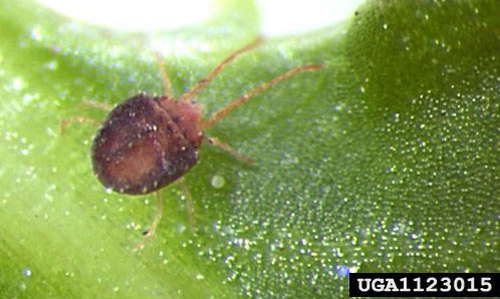
It is during the spring, however, that the mites become the greatest nuisances to homeowners. As early as mid-January, in southeastern Pennsylvania, warm weather spells can produce activity from overwintering mites. Mites located in the vicinity of buildings may climb the exterior walls and gain entrance around windows or doors. If the mites are overwintering under the building siding or within the wall voids, they may become active and enter the living areas rather than exiting to the outside. Clover mites are plant feeders that occasionally invade homes. These mites do not attack people, and although vast numbers of them can enter homes, they will not reproduce under indoor conditions and will perish shortly of their own accord.
thoughts on “How to Get Rid of Clover Mites (and Keep Them Away!)”
Some veggies may be sensitive to oils, so test it on a non-obvious leaf first to see how the plant reacts. There is no single solution that’ll get rid of the mites outside. Seal up any cracks from the outside to prevent more mites from coming inside.
Mites in the outside yard
In the Spring of 2021 I noticed a lot of bug activity in the basement around our egress window. After a few days of normal treatment, I called my pest control provider to come do a special treatment and they confirmed I was dealing with clover mites. Thick shrubbery around homes creates the perfect conditions for a clover mite infestation. Populations of the insects are at their peak in the spring and early fall, when plants are thriving. If you have clover mites in a vegetable garden, you’ll want to be careful and avoid any harsh chemicals on your edible plants.
Solved! What Are These Bugs That Look Like Cockroaches in My Home?
That being said, the window sills and doors I can typically find a few if I look. I created this site to offer my 8 years of natural pest control experience to the public. These mites are difficult to fully manage without a professional, but you can still significantly reduce their population by using home remedies. If you need to use a commercial pesticide to kill them because the home remedies aren’t cutting it, look for something with permethrin as an active ingredient. This works effectively against arachnids and will kill them upon contact. Clover mites are difficult to fully eradicate because they’re hard to see.
As long as you’re taking good care of your plants, however, the clover mite feeding damage will only be cosmetic. They don’t carry any plant viruses or other diseases like some sap-sucking creatures. And small clover mite populations just really can’t overpower healthy plant tissues. Clover mites are one of many nearly microscopic arachnids that feed with sucking mouthparts. But, because they can breed in enormous numbers, they’re practically invisible existence sometimes becomes a lot more obvious when they congregate around homes and other structures. Supreme IT is a broad-spectrum insecticide that is labeled for treating clover mites.
Overwintering mites hatch in the spring and begin to produce second generations. Spring generations will aestivate, which is a form of summer hibernation where mites go inactive on warm, dry days. "To prevent these mites from having easy access to your home, remove or relocate plants and vegetation from the sides of the house," she suggests. Another route Crumbley recommends homeowners take is "mixing in plants that clover mites do not attack" to discourage them from feeding on your gardens. Some repelling plants Crumbley notes include geranium, chrysanthemum, marigold, or certain shrubs like juniper. Crumbley says that depending on different mite species, each will burden our homes differently.
Various Cover Crops That Will Help Suppress Weeds In Your Garden
In addition, their tiny size means they’d be unable to damage human skin even if they were capable of biting. They do not bite, sting, or transmit disease, nor do they cause any structural damage. The biggest annoyance is the red stain they leave behind when crushed. They feed exclusively on plants, particularly grass and clover. If you are still finding yourself with an abundance of clover mites indoors, you may need to call in a pest control specialist.
The southern red mite (Oligonychus ilicis) attacks a wide range of plants, edibles as well as ornamentals. Their preferred host are azaleas, hollies, rhododendron, camellias, and cherry laurel. They suck fluids out of the leaf cells, starting on the lower surfaces of plants. When populations are high, however, these mites will feed on the upper surfaces as well with the result of leaf discoloration, distorted leaves, leaf drop, and dieback. Southern red mites are cool-season mites that are the most active during the spring and fall when they rapidly reproduce. It can also help to prevent clover mites from approaching your home by removing a band of turf 18 to 24 inches wide all the way around.
How do I get rid of clover mites?
You'll find the grain also does an excellent job of improving soil health and preventing soil erosion. Michigan State University reports that red clover is the most popular choice when it comes to cover crops, and for good reason. The denseness of the crop provides excellent weed suppression. Red clover also draws beneficial insects to the garden, like bees, hummingbirds, and butterflies, while adding nitrogen to the soil. While soil pH isn't much of an issue with hairy vetch, you will need to make sure the earth is well-draining and free of rocks and debris (with an optimal pH between 6.0 to 7.0). The crop is best planted between August and September at a broadcast rate of 25 to 40 pounds per acre.
Finally, they can sometimes come indoors in the autumn when their food sources begin dying out. Chigger bites can cause itching and irritation, but they typically detach from humans within a few hours. Chiggers are most active during the warmest months of the year, but they can be active nearly year-round in the South. They molt as they grow, and though their shape does not change much, their color fades or darkens. Solutions is committed to providing the best professional pest control products for every need.
Since they’re often hiding in your grass and lawn, they’ll be hard to see. You can spray an even layer across your lawn to act as a deterrent. Stagnant water will provide soft soil and also erode weathered surfaces, which can allow clover mites to enter and build a nest. The moat should be at least 24” in length and you can fill it with dry, bare soil.
Campbell Vaughn: Wee critters are clover mites, but don't squash 'em - The Augusta Chronicle
Campbell Vaughn: Wee critters are clover mites, but don't squash 'em.
Posted: Thu, 16 Apr 2020 07:00:00 GMT [source]
Over time I’ve been able to control myself more about looking for them and reminding myself they are harmless. It still sucks that there’s not an eradicating solution and based on the comments in here, I don’t have a lot of hope one will be discovered. No, nothing worked, and nothing continues to work to the effect I was hoping. I’m not seeing them on the walls while eating dinner, not finding them in my bed, and they aren’t up on the ceiling while taking a shower.
To share feedback or ask a question about this article, send a note to our Reviews Team at Once you have completed the inspection, you should then prep your lawn for chemical treatment. Before applying chemicals, we recommend putting on personal protective equipment to keep yourself safe during application.
The biggest challenge with them will be the sheer number that you may encounter. To accomplish uniform control when applying to dense grass foliage, use volumes of up to 10 gallons per 1.000 sq. Measure the square footage of your lawn to determine how much Supreme IT you need to cover the entire area. If Clover mites have already found a way into your home, don't panic; use Pyrid Aerosol. This fast-acting spray delivers a quick knockdown, killing Clover Mites with contact as you spray. Use as a space spray as well as on cracks and crevices where Clover Mites are hiding.

This acts as a barrier to the mites to prevent them from crossing into your yard. Try a few of the DIY solutions here and if none of them work, contact a local pest control company and get an evaluation. Avoid watering your plants excessively as the excess unused water leads to more mites. You can use an old sponge to remove the mites from surfaces and leave behind a repelling scent. Get a shop vac and vacuum up the surfaces where you see a lot of mite activity.
Because clover mites are so small, keeping them out of your home can be very difficult, but you should start by caulking around windows and sealing doors well. While many recommend the use of pesticides to deal with an infestation, learning how to get rid of clover mites naturally is safer for you, your household, and the planet. According to the EPA, some pesticides are carcinogens, while others can cause problems with the endocrine system, nervous system, and other important functions. Anytime between September and November is a good time to plant fava beans as a cover crop. Preferred soils include heavy silt, clay loams, and sandy soils that drain well (with an optimal pH between 6.5 and 9.0). Apply the seeds at a rate of 79 pounds per acre, making sure the seeds are at least 1 inch deep.


No comments:
Post a Comment